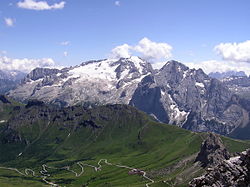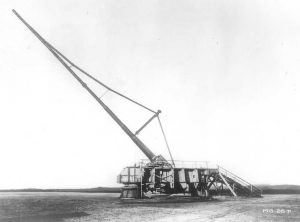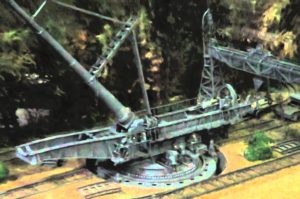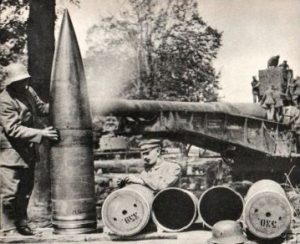weapon
 There a number of ways for a soldier to be killed in a war, but we very seldom think of an avalanche as one of them. Nevertheless, on Dec 13, 1916, hundreds of Austrian soldiers in a barracks near Italy’s Mount Marmolada, were killed when a powerful avalanche came sweeping over them. As shocking as this seems, over a period of several days, avalanches in the Italian Alps killed an estimated 10,000 Austrian and Italian soldiers that December.
There a number of ways for a soldier to be killed in a war, but we very seldom think of an avalanche as one of them. Nevertheless, on Dec 13, 1916, hundreds of Austrian soldiers in a barracks near Italy’s Mount Marmolada, were killed when a powerful avalanche came sweeping over them. As shocking as this seems, over a period of several days, avalanches in the Italian Alps killed an estimated 10,000 Austrian and Italian soldiers that December.
The avalanches occurred as the Austrians and Italians were fighting World War I, but some witnesses claimed that the avalanches were purposefully caused to use as a weapon. I suppose that could be a possibility, but there was little evidence to prove that theory. Nevertheless, it is possible that avalanches could have been used as an unusual weapon of war at times during the war. It would make sense to use whatever was at your disposal, and the heavy snow could be an easy weapon of mass destruction.
The Italians entered World War I on the side of Britain, France, and Russia against Germany and Austria-Hungary in late April 1915. Over the next three years, a series of bloody battles between the Italian army and the Austrians occurred in the mountainous region along the Isonzo River near the Italian-Austrian border. The weather conditions in the mountains were often a bigger hazard than the actual fighting. An Austrian officer once said “The mountains in winter are more dangerous than the Italians.” This was certainly true in mid-December 1916 when heavy snowfall in the Alps created conditions ripe for avalanches. That left hundreds of Austrian troops, who were stationed in a barracks near the Gran Poz summit of Mount Marmolada, in particular danger. The camp there was well-placed to protect it from Italian attack, but it was vulnerable because it was situated directly under a mountain of unstable snow. The approximately 200,000 tons of snow, rock, and ice plunged down the mountain directly  onto the barracks on December 13, killing 300 soldiers. About 200 soldiers were pulled to safety, but of the dead, only a few bodies were recovered.
onto the barracks on December 13, killing 300 soldiers. About 200 soldiers were pulled to safety, but of the dead, only a few bodies were recovered.
As heavy snow and high winds continued over the next week, incidents like the one at Marmolada continued to happen with disturbing frequency. Entire regiments were lost in an instant. Some of the bodies of victims weren’t found until spring. The best estimate of the losses incurred that fateful December is somewhere between 9,000 and 10,000 soldiers…a shocking number for a weapon of mass destruction that we wouldn’t have ever expected to be a weapon of war at all.

 It seems as if the nations will never be satisfied until they have a new and stronger weapon that will easily destroy a massive amount of people in one shot. Wars are a part of life here on Earth, and will be until the end of time, so we might as well get used to that fact. World War I was not a different time when it comes to weapons of war, in fact on March 23, 1918 at 7:20am, an explosion took place in the Place de la Republique in Paris, and it hailed the first attack of a new German gun. The Pariskanone, Paris-Geschütz, or Paris gun, as it came to be known, was manufactured by Krupps. The Pariskanone was 210mm, with a 118-foot-long barrel. It could fire a shell an impressive distance of some 130,000 feet…25 miles into the air. Three of them fired on Paris that day from a gun site at CrÉpy-en-Laonnaise, a full 74 miles away. The city of Paris was reeling. Paris had withstood all earlier attempts at its destruction, including scattered bombings, but this would be different. It was first thought by the Paris Defense Service, that the city was being bombed, but soon they determined that it was actually being hit by artillery fire. It was a previously unimagined situation. I’m sure everyone wondered how the Germans could have made such a weapon.
It seems as if the nations will never be satisfied until they have a new and stronger weapon that will easily destroy a massive amount of people in one shot. Wars are a part of life here on Earth, and will be until the end of time, so we might as well get used to that fact. World War I was not a different time when it comes to weapons of war, in fact on March 23, 1918 at 7:20am, an explosion took place in the Place de la Republique in Paris, and it hailed the first attack of a new German gun. The Pariskanone, Paris-Geschütz, or Paris gun, as it came to be known, was manufactured by Krupps. The Pariskanone was 210mm, with a 118-foot-long barrel. It could fire a shell an impressive distance of some 130,000 feet…25 miles into the air. Three of them fired on Paris that day from a gun site at CrÉpy-en-Laonnaise, a full 74 miles away. The city of Paris was reeling. Paris had withstood all earlier attempts at its destruction, including scattered bombings, but this would be different. It was first thought by the Paris Defense Service, that the city was being bombed, but soon they determined that it was actually being hit by artillery fire. It was a previously unimagined situation. I’m sure everyone wondered how the Germans could have made such a weapon.
Before the day was over, the shelling had killed 16 people and wounded 29 more. The Germans continued the shelling of that year in several phases between March 23 and August 9, 1918. Over that time, the gun caused a total of 260 deaths in Paris. It was a low number due to the fact that the residents of Paris quickly learned to avoid gathering in large groups during periods of shelling. With less people in each area, the casualties were limited substantially. Nevertheless, the weapon had a terrifying effect on the people and a horrific impact on property in the areas of the shelling. Almost all information about the Pariskanone, one of the most sophisticated weapons to emerge out of World War I, disappeared after the war ended. Later, the Nazis tried 
 without success to reproduce the gun from the few pictures and diagrams that remained. Copies were deployed in 1940 against Britain across the English Channel, but failed to cause any significant damage….a good thing for the people of the Britain at that time. When I look at the pictures of the weapon, I am reminded of the old “Wild, Wild, West” show. There always seemed to be some strange new fangled weapon of destruction in use there too.
without success to reproduce the gun from the few pictures and diagrams that remained. Copies were deployed in 1940 against Britain across the English Channel, but failed to cause any significant damage….a good thing for the people of the Britain at that time. When I look at the pictures of the weapon, I am reminded of the old “Wild, Wild, West” show. There always seemed to be some strange new fangled weapon of destruction in use there too.

